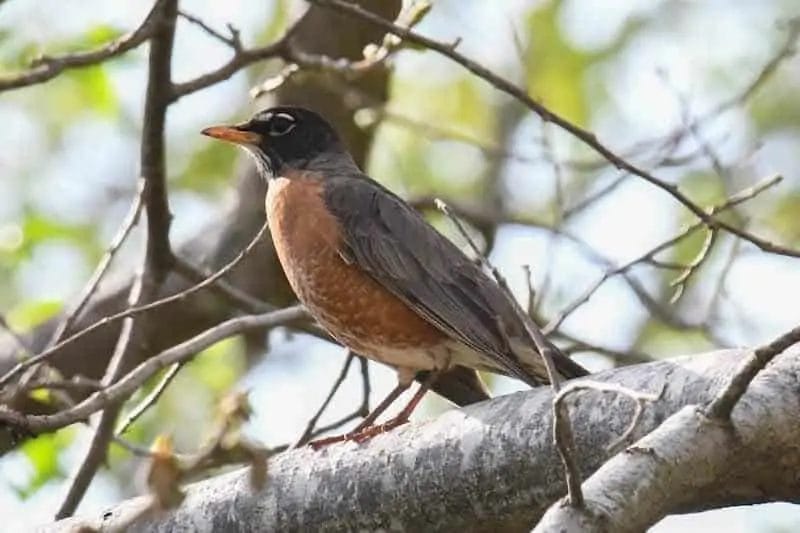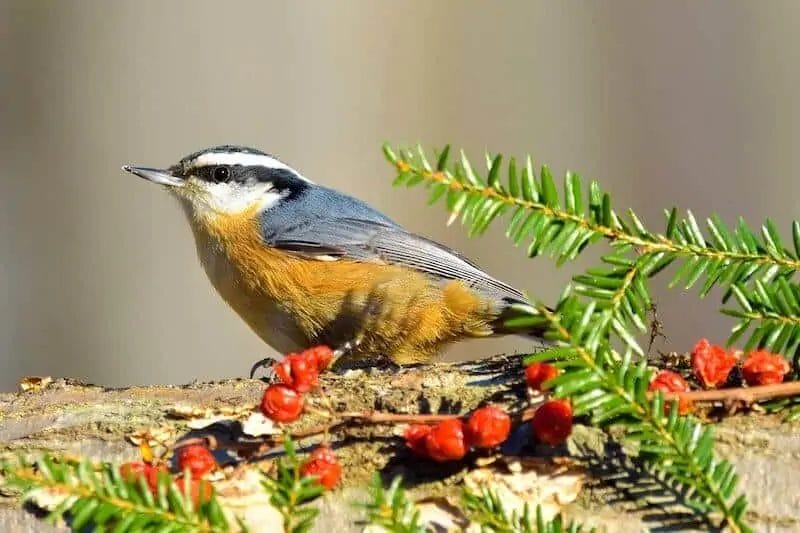Birds Of Washington State- Top12 Birds (Pictures, Facts)
Many species of birds call the state of Washington home. Some of these species live in Washington all year, others are migratory and only spend the summer or winter in the state. In this article, we’re going to take a look at 26 of the most common backyard birds in Washington and learn a little about each species.
After that, I’ll show you how to attract them to your yard, and give you a crash course on the 10 different types of bird feeders you can use. Lastly, I’ll mention a few birdwatching hotspots in Washington and some great local birding organizations.
How many different species of wild birds are in Washington?
It’s difficult to get an exact number of how many bird species are found in North America, the United States, or even in the state of Washington. However, according to the Washington Ornithological Society, as of 2020 there have been at least 520 species of birds seen in the state of Washington.
For this article, we are just going to look at some of the species people frequently see in Washington, especially in backyards.
1. BLACK-CAPPED CHICKADEE

Birds Of Washington State
Scientific name: Poecile atricapillus
Length: 4.7-5.9 in
Weight: 0.3-0.5 oz
Wingspan: 6.3-8.3 in
Chickadees are tiny little birds with rounded bodies that are very easy to recognize because of their “black cap” and black bib. Their cheeks are solid white, their wings and backs are blackish gray, and their underbodies are fluffy and light. They are very common at bird feeders and are often seen darting back and forth from a feeder to cover and back again for more. Chickadees are always among the first birds I see visiting a new feeder in my yard, and they can be quite bold for their size!
Black-capped chickadees can be found year-round throughout Washington.
2. ANNA’S HUMMINGBIRD

Birds Of Washington State
Scientific name: Calypte anna
Length: 3.9 in
Weight: 0.1-0.2 oz
Wingspan: 4.7 in
Anna’s Hummingbird is one of the most common hummingbirds along the western coast of the United States. Males have a green body, light breasts, and pink feathers on their throat, forehead, and behind their eyes. Females lack bold pink feathers but may have a few pink/red spots on the throat. Many species of hummingbirds migrate south of the border during winter, but the Anna’s generally stay put in the western U.S., migrating only very short distances if they need to find a new feeding ground.
3. AMERICAN GOLDFINCH

Birds Of Washington State
Scientific name: Spinus tristis
Length: 4.3-5.1 in
Weight: 0.4-0.7 oz
Wingspan: 7.5-8.7 in
Goldfinches are among my favorite birds to see at feeders, especially when they have their bright yellow feathers in the Spring and Summer. During this period they are mostly yellow, or “gold”, with black-tipped wings, and males have a black cap on top of their heads. During winter they will molt and their bright yellow fades out to a more dull brownish or olive tone. You can always recognize them any time of year by the black on their wings, and their finch-like beaks.
4. BARN SWALLOW

Birds Of Washington State
Scientific name: Hirundo rustica
Length: 5.9-7.5 in
Weight: 0.6-0.7 oz
Wingspan: 11.4-12.6 in
Barn swallows, birds of the open field. These beautifully colored birds have a dark blue back, orange between the eyes and on the throat. Their breast and belly can be anything from a light tawny color to bright orange. One of their trademarks is their long, deeply forked tail. They are very agile fliers that cruise and swoop over water, fields, farms, and meadow catching insects in the air. They use a combination of mud and grass to create cup-shaped nests, which are often found in the eaves of barns, gazebos, covered pavilions, and under bridges.
Barn swallows migrate to the U.S. to breed, and you can find them throughout Washington during the spring and summer.
5. WHITE-CROWNED SPARROW

Birds Of Washington State
Scientific name: Zonotrichia leucophrys
Length: 5.9-6.3 in
Weight: 0.9-1.0 oz
Wingspan: 8.3-9.4 in
White-crowned sparrows spend the summer far north in Canada and Alaska, then migrate back down across the United States during the winter. One of the easier sparrows to identify, white-crowned sparrows have a bold black and white striped head while the rest of their face, chest, and belly remain a plain buffy brown-gray. They like to forage in fields, and along the edges of roads and trails. These sparrows will come to bird feeders but are most likely to stay on the ground and pick up spilled seed.
Throughout most of Washington, these sparrows will only be found during the winter. However right along the coast, many remain year-round.
6. RED-WINGED BLACKBIRD

Birds Of Washington State
Scientific name: Agelaius phoeniceus
Length: 6.7-9.1 in
Weight: 1.1-2.7 oz
Wingspan: 12.2-15.8 in
Among the most abundant birds in all of North America, male Red-winged Blackbirds are unmistakable because of their red and yellow “shoulders” that stand out amongst their black bodies. The females of this species, however, look quite different and are mostly brown with light streaks. They are known as a polygynous species, meaning males will have up to 15 different females that they are mating. Unfortunately, they sometimes show up at feeders in flocks and gobble up seed quickly.
7. AMERICAN ROBIN

Birds Of Washington State
Scientific name: Turdus migratorius
Length: 7.9-11.0 in
Weight: 2.7-3.0 oz
Wingspan: 12.2-15.8 in
Common in backyards, robins are mostly seen hopping around the grass looking for worms and other invertebrates to eat. While they will occasionally visit bird feeders, they do not typically eat seeds. Their bright orange round bellies, yellow beaks, and larger size make them easy to identify. They are frequent singers and can be heard from dawn to dusk.
8. RED-BREASTED NUTHATCH

Birds Of Washington State
Scientific name: Sitta canadensis
Length: 4.3 in
Weight: 0.3-0.5 oz
Wingspan: 7.1-7.9 in
These little nuthatches have a dark gray back, rusty (ranges from boldly colored to pale) chest and belly, and a boldly black and white striped face. They are quick and active birds most commonly found hopping around on tree trunks and branches looking for insects beneath the bark. They nest in tree cavities, and will even use backyard nest boxes.
Red-breasted Nuthatches are found year-round in most of Washington, but there may be areas where they are seen more often in the winter.
9. EUROPEAN STARLING

Birds Of Washington State
Scientific name: Sturnus vulgaris
Length: 7.9-9.1 in
Weight: 2.1-3.4 oz
Wingspan: 12.2-15.8 in
100 starlings were set loose in New York in the 1890s and they have since taken over the country. They destroy other birds’ nests, kill their young, and will overtake feeders not allowing other birds to get any of the food that you put out. They are mostly all dark with white specks on their backs and wings and have yellow beaks and feet. Starlings can also be a purple and green iridescent color and in the right light can be quite pretty.
10. BLACK-HEADED GROSBEAK

Birds Of Washington State
Scientific name: Pheucticus melanocephalus
Length: 7.1-7.5 in
Weight: 1.2-1.7 oz
Wingspan: 12.6 in
Black-headed Grosbeaks spend their winters in Mexico, so their annual return to the U.S. is exciting for my backyard bird lovers. While females are a streaky brown on the back with a light breast and brown and white striped face, males have more striking colors. They have a black head and back with white wing spots and a bright orange breast with some yellow on the belly. Their fat beaks can help them break open tough seeds. Males share equal duty with females when it comes to incubating eggs and feeding the babies.
Black-headed Grosbeaks can be found throughout Washington only during the spring and summer breeding season.
11. HOUSE FINCH

Birds Of Washington State
Scientific name: Humorous Mexicans
Length: 5.1-5.5 in
Weight: 0.6-0.9 oz
Wingspan: 7.9-9.8 in
The House Finch is a very common backyard bird within their range. They are west coast natives and didn’t spread to the eastern U.S. until the 1940s when caged finches they were trying to sell were set loose. If you attract them, which is fairly easy to do, they may show up in small flocks and mob your feeders. Both sexes are brown with heavy white streaking. Males have red splashes on their heads, chest, and back.
12. HOUSE SPARROW

Birds Of Washington State
Scientific name: Passer domesticus
Length: 5.9-6.7 in
Weight: 0.9-1.1 oz
Wingspan: 7.5-9.8 in
Generally looked at as pests, House Sparrows are the only other species of wild birds in the U.S. besides starlings that you can legally trap and humanely kill. Like starlings, they were introduced in New York in the 1800s and have since spread across our country like wildfire as an invasive species. They are mostly brown, with some black and brown streaking on their wings and buffy chest. Males often stand out with black masks and chests. They are overall aggressive towards other birds, especially around nests and birdhouses.
Read More Article: Why Do Birds Suddenly Appear?
Read More Article: How Long Do Birds Live
Read More Article: Tropical Birds- Top 8 Tropical Birds
Read More Article: Bird Flying
Read More Article: How Do Birds Mate-Everything Explained
Read More Article: German Shepherd Pitbull Mix






